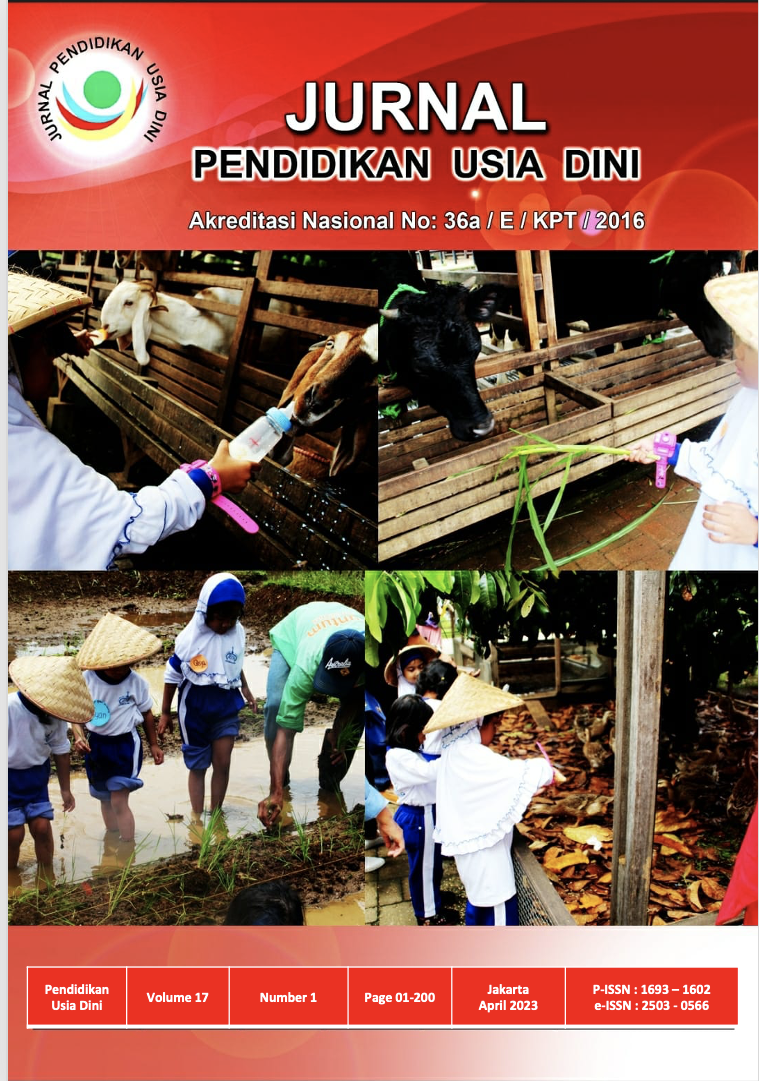The Effect of Digital Card Media Towards Children’s Ability to Recognize Letters
DOI:
https://doi.org/10.21009/JPUD.171.04Abstract
The background of this research is the low ability to recognize letters for group B children in Pembina State Kindergarten, Gorontalo District, Gorontalo City. Children do not know the various forms of the alphabet and letters, and the letters written by children are still mixed up or upside down. This lack of ability is caused by teachers not using creative and interesting media to stimulate children's abilities. So, this study aims to see an increase in the ability to recognize letters with creative and practical media. This research method uses a quantitative experimental method with a purposive sampling technique. Data collection was carried out using observation techniques and performance tests. The sample involved 16 respondents (7 male and 9 female). The results of the study show that learning using a blackboard is less effective in improving children's letter recognition skills, especially in aspects of language development. The findings recommend that schools be asked to evaluate and review each learning strategy, planning, and implementation. It is recommended that early childhood educators improve their competence in designing learning activities that are innovative, creative, interesting, and based on digital technology.
Keywords: digital card media, letters recognition ability, early childhood
References:
Aleksandar Trifunović, Svetlana Cicević, Dragan Lazarević, Slobodan Mitrović, & Magdalena Dragović. (2018). Comparing Tablets (Touchscreen Devices) and Pcs in Preschool Children’ Education: Testing Spatial Relationship Using Geometric Symbols on Traffic Signs. IETI Transactions on Ergonomics and Safety, 2(1). https://doi.org/10.6722/TES.201808_2(1).0004
Alqahtani, M. (2015). The importance of vocabulary in language learning and how to be taught. International Journal of Teaching and Education, III(3), 21–34. https://doi.org/10.20472/TE.2015.3.3.002
Ardini, P., & Handini, M. (2018). The Influence of Instructional Method, Visual Spatial Intelligence, and School Readiness on Early Reading Abilities. Journal of Scientific Research and Reports, 17(4), 1–22. https://doi.org/10.9734/JSRR/2017/38737
Ashcroft, R. J., Cvitkovic, R., & Praver, M. (2018). Digital flashcard L2 Vocabulary learning out-performs traditional flashcards at lower proficiency levels: A mixed-methods study of 139 Japanese university students. The EuroCALL Review, 26(1), 14. https://doi.org/10.4995/eurocall.2018.7881
Borre, A. J., Bernhard, J., Bleiker, C., & Winsler, A. (2019). Preschool Literacy Intervention for Low-Income, Ethnically Diverse Children: Effects of the Early Authors Program Through Kindergarten. Journal of Education for Students Placed at Risk (JESPAR), 24(2), 132–153. https://doi.org/10.1080/10824669.2019.1594818
Elias, S., Cromarty, E., & Wilson-Jones, L. (2022). Family Communication and Engagement with Digital Technology: Approaches and Strategies. Journal of Research Initiatives, 6(2).
Elimelech, A., & Aram, D. (2020). Using a Digital Spelling Game for Promoting Alphabetic Knowledge of Preschoolers: The Contribution of Auditory and Visual Supports. Reading Research Quarterly, 55(2), 235–250. https://doi.org/10.1002/rrq.264
Howell, J. J., & Gengel, S. (2005). Perspectives of Effective Teachers of Students with Low-Incidence Disabilities. TEACHING Exceptional Children Plus, 1(4).
Kapiso, W., Djuko, R. U., & Laiya, S. W. (2021). Kemampuan Mengenal Huruf Anak Usia 5-6 Tahun Di Taman Kanak-Kanak [Ability to Recognize Letters for Children Aged 5-6 Years in Kindergarten]. Student Journal of Early Childhood Education, 1(1).
Karoma, S. (2019). Peningkatan Kemampuan Mengenal Lima Huruf Vokal Melalui Media Bola Huruf Pada Anak Usia 3-4 Tahun [Improving the Ability to Recognize the Five Vowel Letters Through Letter Ball Media in Children Aged 3-4 Years]. JECED : Journal of Early Childhood Education and Development, 1(1), 60–66. https://doi.org/10.15642/jeced.v1i1.501
Maulidya, A. R., Sa’dullah, A., & Lismanda, Y. F. (2019). Peningkatan Kemampuan Mengenal Huruf Vokal Melalui Media Pohon Huruf Pada Anak Usia 3-4 Tahun Di Kelompok Bermain Stroberi Restu 1 Malang [Improving the Ability to Recognize Vocal Letters Through the Media of Letter Trees in Children Aged 3-4 Years in the Strawberry Restu 1 Playgroup Malang]. Dewantara: Jurnal Ilmiah Pendidikan Islam Anak Usia Din, 1(2).
Nasution, T. A. (2017). Pengaruh Permainan Kartu Huruf terhadap Pengenalan Bentuk Huruf pada Anak Usia 5-6 Tahun di TK Salsa Cinta Rakyat Kecamatan Percut Sei Tuan T.A. 2016/2017 [The Effect of Letter Card Games on Letter Form Recognition in Children Aged 5-6 Years at Salsa Cinta Rakyat Kindergarten, Percut Sei Tuan District T.A. 2016/2017]. Jurnal Usia Dini, 3(1). https://doi.org/10.24114/jud.v3i1.14654
Ningtyas, D. P. (2014). Improving Early Reading Ability Through the Snake and Ladder Game. Jurnal Pendidikan Usia Dini, 8(2). https://doi.org/10.21009/JPUD.082
Nobre, J. N. P., Vinolas Prat, B., Santos, J. N., Santos, L. R., Pereira, L., Guedes, S. da C., Ribeiro, R. F., & Morais, R. L. de S. (2020). Quality of interactive media use in early childhood and child development: A multicriteria analysis. Jornal de Pediatria, 96(3), 310–317. https://doi.org/10.1016/j.jped.2018.11.015
Rahayuningsih, S. S., Soesilo, T. D., & Kurniawan, M. (2019). Peningkatan Kemampuan Mengenal Huruf Pada Anak Usia 5-6 Tahun Melalui Metode Bermain Dengan Media Kotak Pintar [Improving The Ability Of Letters Recognizing By Children Aged 5 To 6 Years Old Through Playing Method With A ‘Smart Box’ Media]. Scholaria: Jurnal Pendidikan dan Kebudayaan, 9(1), 11–18. https://doi.org/10.24246/j.js.2019.v9.i1.p11-18
Rakimahwati & Nisaaul Hanifah. (2022). Development of Android-Based Educational Games to Improve Letter Recegnition Ability in Early Childhood in Kinali Pasaman Barat. Proceedings of the 6th International Conference of Early Childhood Education (ICECE-6 2021), 206–212. https://doi.org/10.2991/assehr.k.220602.042
Seefeldt, C., & Wasik, B. A. (2002). Kindergarten: Fours and Fives Go to School. Merrill. https://books.google.co.id/books?id=vzsMAAAACAAJ
Surtika, T., Sumardi, S., & Yasbiati, Y. (2020). Pengaruh Media Puzzle Huruf Terhadap Kemampuan Mengenal Huruf Pada Anak Kelompok A Di Tk Ar-Rahman Kecamatan Sukahening [The Effect of Letter Puzzle Media on the Ability to Recognize Letters in Group A Children in Kindergarten Ar-Rahman, Sukahening District]. JURNAL PAUD AGAPEDIA, 3(1), 101–111. https://doi.org/10.17509/jpa.v3i1.26672
Zahara, P., Miftah, H., Valencia, A., Nurhasanah, A., & Nuraini. (2022). Developing Aplication-based Puzzle Learning Media on Increasing Child’s Ability to Recognize Letters. International Journal of Ethnoscience, Bio-Informatic, Innovation, Invention and Techno-Science, 2(01), 44–49. https://doi.org/10.54482/ijebiiits.v2i01.192
Downloads
Published
How to Cite
Issue
Section
License
JURNAL PENDIDIKAN USIA DINI work is licensed under a Creative Commons Attribution 4.0 International License. (http://creativecommons.org/licenses/by/4.0/)





